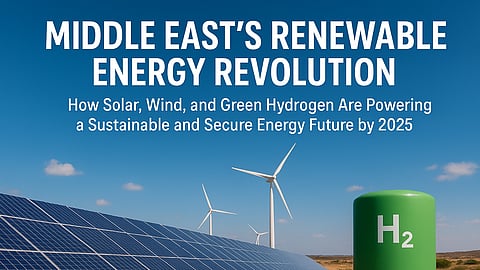Middle East’s Energy Revolution: How Renewables Are Powering a Sustainable and Secure Energy Future
The Middle East is rapidly becoming a global leader in solar energy. The Mohammed bin Rashid Al Maktoum Solar Park in Dubai, projected to be the world's largest, aims to generate 5,000 MW by 2030, supplying power to nearly two million homes and reducing carbon emissions by over eight million tonnes annually.
The sixth phase of this project, currently under development, has achieved a record-low Levelized Cost of Electricity (LCOE) of €0.0139/kWh, underscoring the region's commitment to cost-effective renewable energy.
In 2024, the MENA region's solar capacity reached 24 GW, with Saudi Arabia, the UAE, and Egypt accounting for over 80% of this growth. Morocco is also emerging as a leader in North Africa, surpassing 2 GW of installed solar capacity.
Wind Energy and Grid Modernization
While solar energy leads, wind power is gaining traction in countries like Egypt and Oman. Oman is investing in hybrid systems that combine solar and wind energy to enhance grid stability. The region is also focusing on battery energy storage systems (BESS) to address the intermittency of renewable sources.
Green Hydrogen: The Fuel of the Future
The Middle East is positioning itself as a key player in the green hydrogen market. Countries like Oman and the UAE are developing green hydrogen hubs to export clean energy to global markets. These initiatives are part of broader efforts to diversify energy sources and reduce carbon footprints.
Policy Initiatives and International Collaboration
National strategies such as Saudi Arabia's Vision 2030 and the UAE's Net Zero 2050 are driving the renewable energy transition. These policies are supported by investments in infrastructure, regulatory reforms, and international partnerships. For instance, Algeria plans to invest $60 billion in energy projects from 2025 to 2029, with a focus on renewable energy and hydrogen production.
Energy Security and Economic Diversification
The shift towards renewable energy is enhancing energy security in the Middle East. By reducing dependence on fossil fuels, countries are mitigating risks associated with global energy market fluctuations. This transition is also fostering economic diversification, creating jobs, and attracting foreign investment.
Looking Ahead
The Middle East's renewable energy sector is poised for continued growth. With ongoing investments, technological advancements, and supportive policies, the region is on track to meet its sustainability goals and play a significant role in the global clean energy transition.
As the world focuses on climate change and sustainable development, the Middle East's renewable energy initiatives serve as a model for other regions, demonstrating that economic growth and environmental responsibility can go hand in hand.


